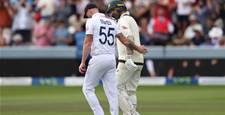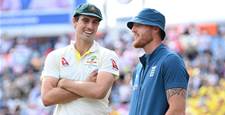But people forget what a fabulous golfer Newton was – a fearless charger, wonderful putter, handsome and charismatic.
But people forget what a fabulous golfer Newton was – a fearless charger, wonderful putter, handsome and charismatic.
 Tom Watson beat Jack Newton to the silverwear at the ‘75 British Open.
Tom Watson beat Jack Newton to the silverwear at the ‘75 British Open.Images: Getty Images
People forget. They know Jack Newton for his charity work in support of junior golf and diabetes awareness, raising piles of cash through his annual Celebrity Classic and corporate competitions; they may know him for his insightful and fearless TV commentary over many years; they may know him as the bloke who walked into the propeller of a light plane in 1983, losing an arm and eye; they may even know him for his son Clint’s rugby league exploits (currently playing in the UK Super League) or his daughter Kristy’s golf career and glamorous good looks; they may know him as the ardent Newcastle Knights fan or for his numerous administrative roles in Australian golf. But people forget what a fabulous golfer Newton was – a fearless charger, wonderful putter, handsome and charismatic. For more than a decade, before his career was so cruelly cut short at the peak of his powers (aged 33), Newton was one of our leading lights in the game’s golden era of the 1970s. He may have missed nabbing a major, but he came close in several, second in two, and won 30 titles in his career. With the US Masters upon us again, still the one major title to elude an Australian, Inside Sport twisted his remaining arm to blow the froth off a brew and the cobwebs off a few memories.
So how are the Newcastle Knights looking for 2009? You still a fan?
(Laughs) Yeah, still a fan but my passion’s not there anymore …
So (coach) Brian Smith hasn’t had a start at your Celebrity Classic yet?
No, not likely.
You were rather annoyed when Clint got shown the door from the Knights in 2007, weren’t you?
Well, that’s been misreported. He wasn’t shown the door at all. He left. And he left because of Brian Smith.
I’d read that Brian had told him he didn’t want him the following year ...
Well, if that’s the case, why was he trying to get him back five weeks later? I think he realised he punted the wrong bloke.
Clint certainly did alright out of the move to Melbourne that year, didn’t he?
Well, he won the comp out of it, so he can thank Brian Smith for that, but nothing else.
You have two fine athletes for offspring. How much credit do you take for that? Are you the Earl Woods type?
(Laughs) No, I’m not. I taught both the kids to play golf when they were young, but really left it up to them. I’m not one of those pushy parents – just a pretty strong armchair critic, you might say. A hard marker.
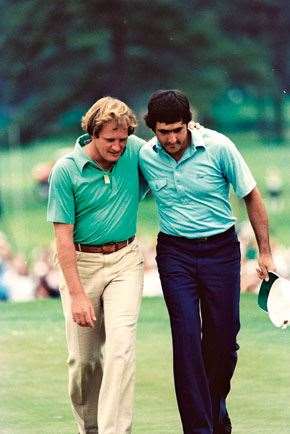 Steve prevailed over his good mate. Images: Getty Images
Steve prevailed over his good mate. Images: Getty ImagesSo, who among this current crop of Australians has the best chance of being the first to pull on the green jacket at the US Masters this month? Or should they just hand it over to Tiger Woods now and save themselves the trouble?
I don’t think they’ll be handing it over to Tiger – I think he’s got a few question marks over his head. Look, I’m very impressed with the bunch of guys we’ve got at the moment. You’ve got the Allenbys and Applebys who’ve been around for a long time, but there’s some younger guys coming through who I rate very highly. But I don’t know that they’re going to win a Masters just yet. It’s quite a unique event. It’s quite a difficult course to get to know on your first go. I played there six times … With the greens the way they are there, lightning fast and usually pretty firm, and the way the wind swirls around in the pine trees down there, and with a fair bit of water on the back nine … You simply must have the right club in your hand, and if a gust of wind comes up it can make you look stupid.
You tied second in 1980. What happened in the second round that year? I looked up the records, and all the scores blew out a bit. You shot a 74 that probably cost you the title.
We got a rain delay and had to go back and finish the next day. I three-putted three times in the five holes I had to play because the pace of the greens had all changed. But I played very well that week. I played with Seve (Ballesteros) in the last round and got to within sight of winning … He was nine in front with nine to play. I made four birdies while he made a double and knocked it in the water on 13. I knew him very well from Europe – we were good mates – so I knew when he starts swearing in Spanish he’s got his knickers in a knot … Then he hooked it off the 14th tee and I thought “right, I’m in here”; I’d hit a good one down the fairway. His ball had gone 50 metres left out on to the 15th fairway, and he had these massive pine trees to go over. And of course, as only Seve could do, he managed to get it on to the back edge of the green and made a miracle par. Then at the 15th par five, we both hit very good shots to be on the green in two. Mine was downhill, hit the lip of the hole, went three feet past, and I missed it coming back. And that was the end of that. He played incredibly well the first three rounds – he was murdering it.
So no nerves for you, in the thick of it on the back nine of the final round of the Masters?
No, I thoroughly enjoyed it. I think I shot 68 on the final round. I really enjoyed coming down the stretch. They’re the things you dream about as a kid and practise for, and I just loved being there.
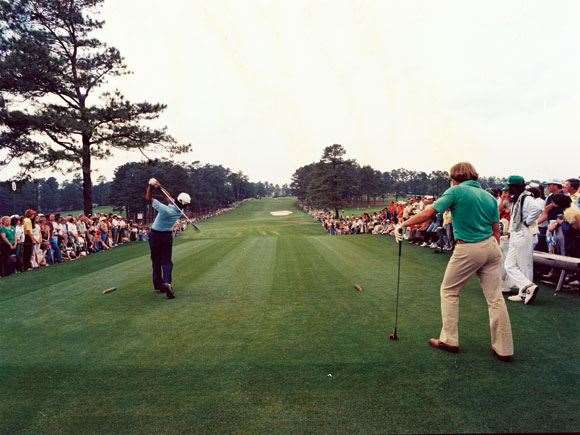 Newton and Seve Ballesteros went shot for shot in the dying stages of the 1980 Masters before ... Images: Getty Images
Newton and Seve Ballesteros went shot for shot in the dying stages of the 1980 Masters before ... Images: Getty ImagesWhere were you watching during the 1975 British Open at Carnoustie, when Tom Watson sank his famous 30-footer at the last to tie with you and force a play-off?
I was playing in the last group. He was two groups in front of me.
Well, that’s wrong information I’ve read there, isn’t it?
Yeah, I’ve seen that written wrong, too. I was two in front with four to play. Hit a pretty good shot on 15, and as traditionally happens in links play, you have to land a ball short of a green sometimes; it copped a bad kick and ran off the green, and I didn’t get it up and down. Then I walked over the hill to the 16th, which is probably one of the most difficult par threes in the game – a long, narrow green. And there were three groups there backed up waiting to play and it was like the Who’s Who of golf at the time – there was Nicklaus and Johnny Miller and Ray Floyd, and they were all on the tee … I don’t think sitting around helped me too much, and watching all these other geezers stopped my momentum a little bit.
So that’s a good half-hour wait to play your next shot?
Yeah, and it’s a three-wood par-three with a green about four metres wide. I didn’t hit a bad shot, but made bogey, and then my caddie and I made a mental error off the tee on 17. There’s two burns (creeks across the fairway) and you have to lay up between them – it was a kinda two-iron and five-iron par-four. I hit a good shot, but we had misjudged a wind shift; I just got over the first burn, but it meant I had one foot almost in the burn and had to hook it back about 40 yards on the line I wanted. I just had to cop it sweet. So I really let everyone back into the event, and Watson, of course, playing up in front of me, holed a long putt and in the end I had to get a par at the last to tie him.Then in the play-off it was nip and tuck all the way. At eight he hooked it off the tee, it was going out of bounds, but it hit a strand of wire and dropped down and he made a miracle par. Then I was one in front at 14 and he holed a sand wedge. Then I bogeyed the last to get beat 71-72 in pouring rain and wind.
Would you have preferred a sudden-death finish?
No, I don’t think one hole’s fair after 72 holes. In a major there’s too much riding on it for sudden-death, but with all the commercialism these days and commitments, that’s where it’s headed.
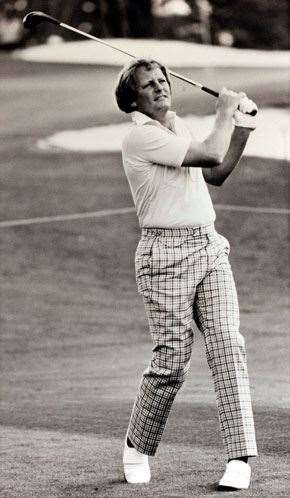 The swingin’ style of Jack Newton, circa early ‘80s. Images: Getty Images
The swingin’ style of Jack Newton, circa early ‘80s. Images: Getty ImagesDid you get a blast seeing The Shark in the hunt at last year’s British Open?
I did, because the way the game’s played now, with the modern equipment, these young blokes tee it up high and just bash it and it goes about four million miles, but they got some fierce wind and Greg’s experience showed. These young blokes were still whacking it up in the air; meanwhile he’s hitting seven irons a hundred metres to keep it under the wind because that’s the way you have to play in those sorts of conditions.
So a bit of a victory for the old school?
You could say that. They’re used to playing in pristine conditions, but British golf isn’t about that – it’s about handling the conditions in front of you on the day.
So where do you stand on the technological advances in golf? Has it altered the character of the game today for the worse?
I’ve been a long-time advocate on that. The golf ball they’re playing with today goes between 45-50 metres further than what we played with. Ten metres is one club – so that’s four to five clubs’ difference when you’re hitting to the green. And you’ve got a graphite driver with a big head on it that hits knuckle balls that just go forever. You’ve got many of the great courses in the world under siege. So they have to trick them up to make them difficult, and that makes a joke of it.
Which is the case at Augusta now, isn’t it?
It’s so long now compared to when I played it, and with very difficult, fast, sloping greens, so you’ve really got to be a long hitter with nerves of steel on the greens, which of course plays right into Tiger’s hands. But it’s not just the ball. With the gear we had you had to learn to play different shots (with the same clubs), so a lot of the good shotmakers are gone - the Lee Trevinos and Ray Floyds and Jack Nicklaus. I’m not saying they’re no good these days, it’s just a totally different game now by comparison.
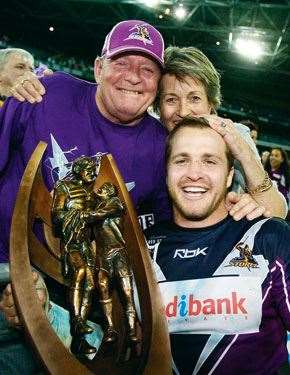 Jack, Jackie and their son, Clint, had the last laugh when the Storm won the comp in 2007.
Jack, Jackie and their son, Clint, had the last laugh when the Storm won the comp in 2007.I grew up watching those blokes – and you. The top golfers’ swings today seem to me to look less athletic, less fluid, much stiffer. Not many swings have personal idiosyncrasies any more. Have you noticed that?
I agree with you. It’s a bit clone-ish, isn’t it? The modern day thought is that if you eliminate the hands and the legs and you just think about your big muscles – your forearms, your shoulders and your rotation – under pressure you can control your big muscles better than your small muscles, ie your hands or your legs. But I contend that the correct method is a combination of both, where your legs work with the upper body rotation. I think the answer is somewhere in the middle. But it’s definitely less complicated than it was in our day. Many of the keys that the top teachers use were things that players had to find out by themselves, and over the years they’ve compiled them, which makes it a lot easier now. That’s why we’re seeing younger and younger players who are more technically correct than ever before.
Are you able to have a bit of an influence on the coaching side through your Junior Golf Foundation?
I’ve stepped into more of an administrative/fundraising type role to try and push the bag of junior golf, which I firmly believe is the future of the game – get more kids playing. Golf’s tended to sit on its arse and not be proactive enough in that area. It’s quite strange: so many top actors, footballers, cricketers all play golf – Kelly Slater plays off about five – but in some areas it’s still perceived as a boring game.
There doesn’t appear to be anyone bored at your Celebrity Classic. It sounds like a hoot. How much money have you raised over the years?
Over $3 million towards junior golf and diabetes awareness. I’ve got diabetes and my father died from complications from it, and I wanted to put something back into a charity that I think needs publicity – the figures are just mind-blowing. It’s an epidemic.
Let’s not finish by dwelling too much on your near misses in majors. You won a heap of trophies. Which one means the most to you?
I’d say the (1979) Australian Open – it’s no secret that I was a proud Aussie wherever I went and the Australian Open in those times was difficult to win because Player, Nicklaus and Palmer pretty much dominated – we always had the best players in those days playing out here. So to win the Australian Open on a really good course in Melbourne with an excellent field – Seve, Gary Player, Fuzzy Zoeller, plus our own great players … But most importantly, I had my dad caddying for me who pretty much taught me how to play. That’s the one I’ll never forget.
– Graem Sims
Related Articles
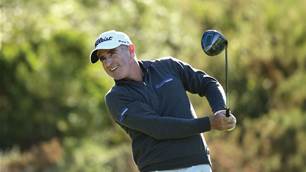
Video interview: Drinks With ... Matt Millar

19 Holes With ... Clint Newton





